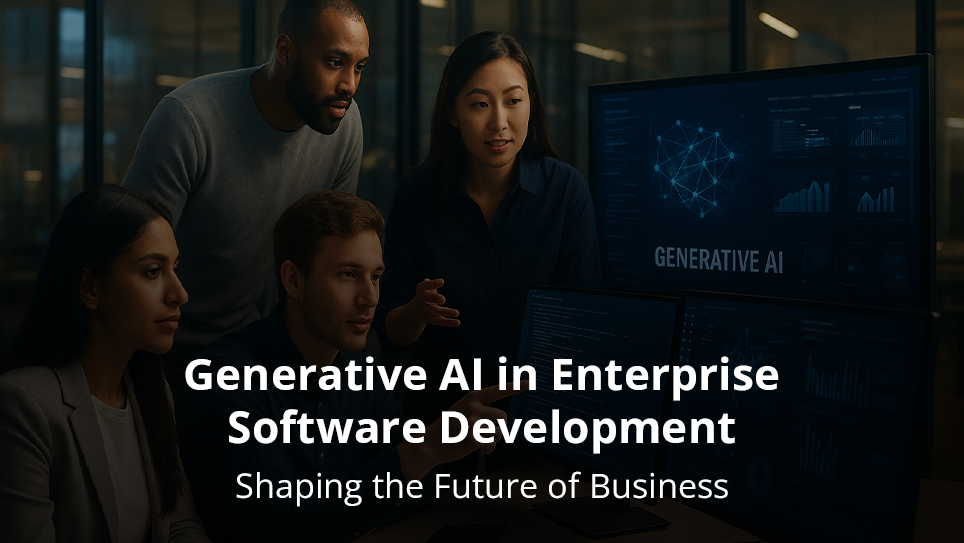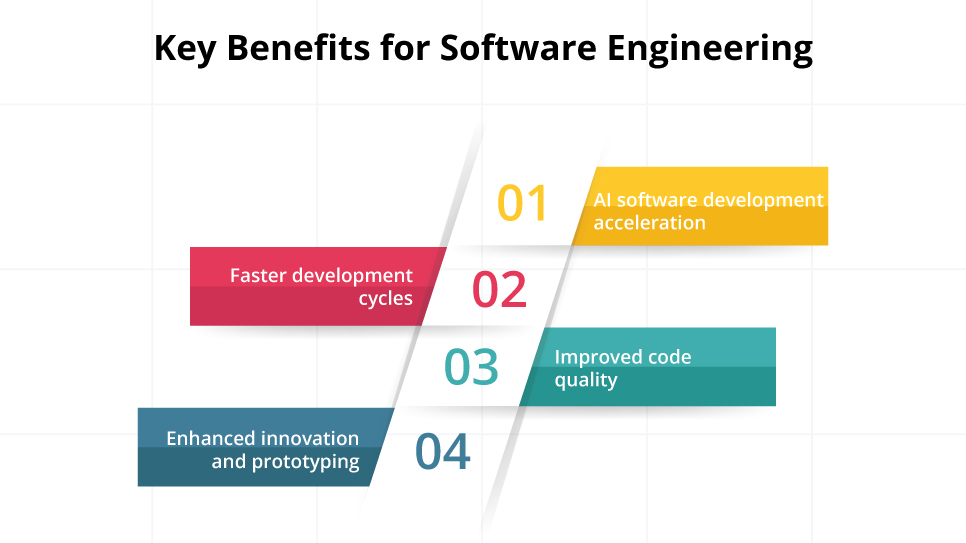Generative AI in Enterprise Software Development: Shaping the Future of Business

AI that generates content for enterprises has come to be identified as an energizer of major power, thus skyrocketing the changes of the software lifecycle from building to maintenance. Thanks to the large language models and deep learning, the enterprise software teams and the product heads are giving developers the power to automate the menial tasks and drive the creative part of the process through. The reallocation of work is thus opening up both the e)- and the creative process: an analysis indicated that the use of generative AI soared from 33% to 71% over the course of a year. In the area of software engineering, tools like GitHub Copilot and AWS CodeWhisperer are already making code generation and automated testing quicker. This tendency indicates that AI is gradually moving from the labs to the production line for code generation and optimization to become the daily routine. The use of generative AI in enterprise development is also altering the job landscape: coders change into architects and reviewers, while the routine coding is left for the AI.
The contrast of generative AI with traditional development paradigms shows great leaps forward in efficiency and speed of the latter. In programming, AI-backed vigilance enables developers to create and test parts of the code in no time at all, compared to not using them. These AI vs. manual coding benchmarks underscore the reason behind the express adoption of AI-driven development workflows by many companies.
Transformative Applications in Enterprise Software Development
Generative AI applications extend across industries and domains. For instance, in healthcare, generative models assist with medical imaging analysis; in finance they automate fraud detection and reporting; and in retail, they drive personalized customer experiences. But perhaps the most striking shift is in enterprise software engineering: developer tools like Amazon CodeWhisperer and GitHub Copilot, two leading enterprise AI tools, automate code generation and testing. These generative AI applications are enabling new efficiencies: for example, AI-driven design tools can create UI wireframes from simple text prompts, and NLP models can auto-generate documentation from code. Each of these examples underscores how generative AI applications are creating new efficiencies for enterprise software teams.
Key Benefits for Software Engineering

Generative AI in enterprise development brings several direct benefits to software engineering:
- AI software development acceleration: AI code assistants reduce manual coding effort by as much as 50%, effectively doubling team output.
- Faster development cycles: Developers report that routine programming tasks that used to take hours can now be done in minutes with AI help. This speed-up cuts time-to-market for features.
- Improved code quality: Enterprise AI tools provide real-time suggestions for best practices, flag bugs, and enforce security standards during coding. This automated oversight reduces defects and vulnerabilities in production software.
- Enhanced innovation and prototyping: By automating routine tasks, generative AI lets teams focus on higher-level design and experimentation. For example, integrating AI prototyping services can generate initial app wireframes or code modules in hours, helping product teams iterate on ideas faster. AI software development tools also automatically produce API documentation and deployment configurations from simple prompts, further speeding engineering workflows.
These benefits not only speed up delivery but also free engineers to tackle complex problems and creative solutions. In fact, benchmark studies show that AI-assisted development yields much higher efficiency than manual coding, which is why generative AI in enterprise is rapidly becoming integral to modern development pipelines.
Integrating Generative AI in Enterprise Workflows
Implementing generative AI in the development process requires the right tools and strategy. Enterprises have several approaches:
- API and SaaS platforms: Many organizations begin by adopting generative AI in the enterprise via cloud services. By connecting to APIs like OpenAI’s or Azure’s LLM services, developers can embed AI helpers directly into their IDEs or CI/CD pipelines. Enterprise AI tools are often accessible as plugins or extensions, allowing teams to prompt an AI to generate functions, refactor code, or document modules on the fly.
- Custom and fine-tuned models: For sensitive or specialized codebases, many companies build or tune their own models. This falls under custom AI model development. Large enterprises train LLMs on proprietary data, which improves relevance and security. For instance, Goldman Sachs fine-tuned its AI assistant on internal code and documentation to give engineers more accurate, context-aware coding help. Custom models ensure that the AI understands the organization’s codebase and domain.
- DevOps and pipeline integration: Teams incorporate generative AI enterprise into their deployment pipelines. AI-enhanced testing tools generate edge-case tests or detect issues automatically. Cloud IaC platforms integrated with AI can automatically write Dockerfiles, Kubernetes configs, or cloud-init scripts based on natural-language prompts. In many cases, companies add AI-based steps in their CI workflows to auto-generate code reviews or optimize configurations, making the entire SDLC more data-driven and automated. For example, AI observability systems now analyze logs to predict failures or suggest code refactors before issues reach production.
Because integrating this technology involves new processes, many enterprises partner with a generative AI consulting firm to plan their approach. These experts can help set up pilot projects, data pipelines, and governance frameworks. At the same time, some teams work with AI prototyping services or in-house innovation labs to quickly build MVPs using AI. Many of today’s enterprise AI tools integrate seamlessly with development and collaboration platforms, so choosing the right provider matters. Companies often evaluate several enterprise AI tools before selecting a strategy. The key is aligning projects with business goals – for example, measuring how AI saves development hours or improves product quality – and continuously iterating on the integration.
Challenges and Considerations

Generative AI in enterprise usage also introduces new challenges. Data privacy and security are critical: AI models trained on code or user data must be handled carefully. For example, Europe’s GDPR rules apply, and regulators have already fined AI companies for misusing personal data. Enterprises need strong data governance, anonymization, and compliance checks to avoid breaches or legal issues when adopting generative AI in enterprise workflows.
Another concern is reliability and ethics. AI-generated code can contain errors, biased logic, or insecure patterns. Companies must implement review processes and testing for all AI outputs. Bain notes many developers initially resist AI tools, so firms should invest in training and change management to build trust. Clear guidelines on code ownership and usage are also needed to address intellectual property issues when using pre-trained models.
Finally, organizations should watch for integration bottlenecks. If deployment or code review processes aren’t updated, faster AI coding could just shift the bottleneck downstream. Leading companies remove these friction points by modernizing their toolchains, for instance, moving to cloud IDEs or microservices, so that generative AI truly accelerates the entire lifecycle. In sum, with the right governance and infrastructure, generative AI in enterprise can deliver major gains; without it, risks like privacy leaks or tech debt may arise.
The Future of AI in Business and Software
All signs point to an AI-driven future for enterprise software. Research suggests that software engineering will be one of the top areas for AI’s economic value. We’re already seeing autonomous AI agents: one startup introduced an AI “software engineer” named Devin that can build and troubleshoot applications from natural-language prompts. In the coming years, such agents may collaborate with human developers, automating large parts of the workflow. Future software roadmaps will likely assume that features can be prototyped and partially coded by AI. Early adopters measure ROI and tie AI outputs to business metrics, as Bain recommends. For enterprise teams and product heads, this means setting an AI-native vision. Organizations that invest in internal AI expertise and flexible infrastructure will gain a competitive edge.
In summary, Generative AI in Enterprise is not just a buzzword; it’s reshaping software development. Companies are already seeing real gains: one fintech startup cut its development cycle by 40% using AI code generation, and another achieved a months-faster MVP launch through AI-driven prototyping. These examples highlight how deeply AI is changing the landscape. For all stakeholders, embracing Generative AI in Enterprise development will be key to staying competitive. Leading companies have made generative AI a core part of their strategy, embedding AI into every level of development. Organizations that fail to adapt generative AI in enterprise risk are falling behind; those that harness it will build better products, faster.
FAQs
Q: What is generative AI in enterprise software development?
A: Generative AI in enterprise development uses large language models to create code, documentation, and UI elements. It acts as a virtual coding partner, turning prompts into functional outputs. This helps teams accelerate delivery and improve productivity across software projects.
Q: What benefits do generative AI tools bring to software engineering?
A: These tools speed up routine coding tasks, often reducing development time by 40–50%. They also improve code quality by detecting issues early and suggesting fixes. As a result, developers can focus on problem-solving, innovation, and faster release cycles with fewer defects.
Q: What are some enterprise AI tools and generative AI applications?
A: Popular enterprise AI tools like GitHub Copilot, Amazon CodeWhisperer, and Azure OpenAI help generate code, test cases, and documentation. Beyond coding, generative AI applications support design mockups, data summaries, and compliance reporting across business functions.
Q: What challenges do enterprises face when adopting generative AI?
A: Enterprises must manage data privacy, compliance, and model accuracy. Risks include exposure of sensitive code, biased outputs, and IP concerns. Strong governance, code reviews, and security policies are essential to ensure safe and responsible AI deployment in development.
Q: How can companies start using generative AI in development?
A: Start with small, high-impact pilots like AI-assisted prototyping or documentation. Partner with a generative AI consulting firm to define goals and select tools. Use secure environments, measure results, and train teams to scale AI adoption efficiently across departments.
Q: What’s the future of AI in business and software?
A: The next phase will see AI evolve from an assistant to a development partner capable of automating full builds. Enterprises will rely on AI to design, test, and optimize software in real time, driving faster innovation and deeper collaboration between humans and machines.
